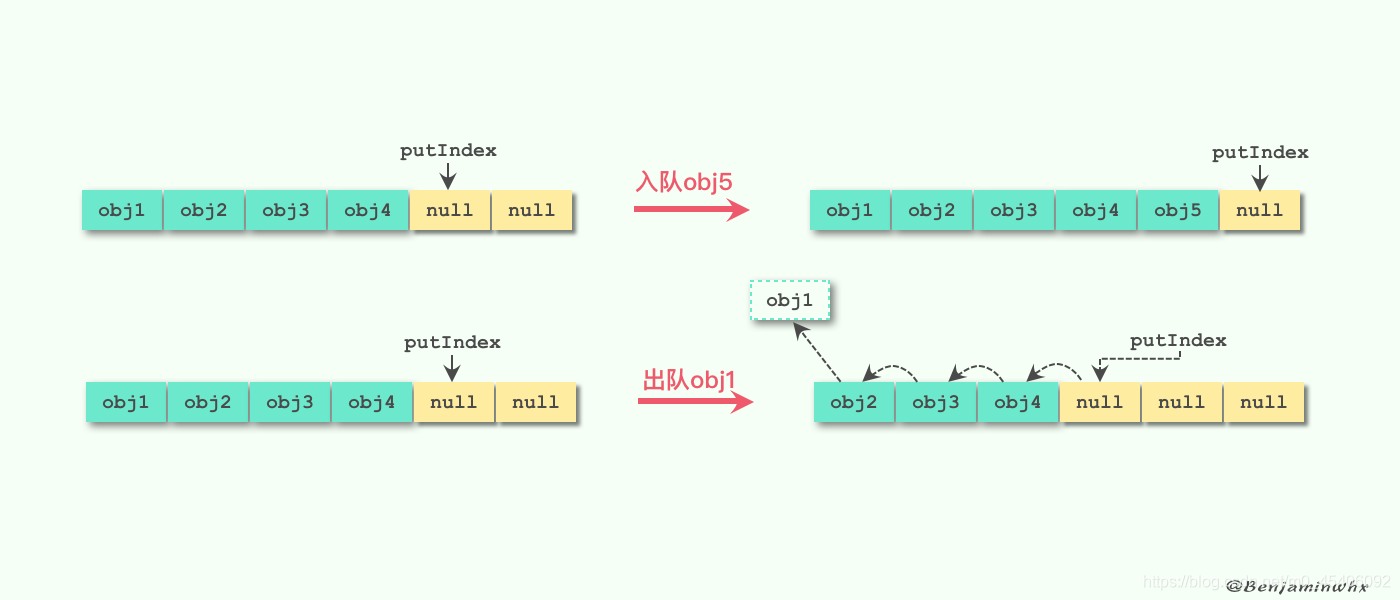文章目录
1、简介
ArrayBlockingQueue,顾名思义:基于数组的阻塞队列。数组是要指定长度的,所以使用ArrayBlockingQueue时必须指定长度,也就是它是一个有界队列。
它实现了BlockingQueue接口,有着队列、集合以及阻塞队列的所有方法,队列类图如下图所示:

既然它在JUC包内,说明使用它是线程安全的,它内部使用ReentrantLock来保证线程安全。ArrayBlockingQueue支持对生产者线程和消费者线程进行公平的调度,默认情况下是不保证公平性的。公平性通常会降低吞吐量,但是减少了可变性和避免了线程饥饿问题。
JUC包指java.util.concurrent目录下的类
2、数据结构
通常,队列的实现方式有数组和链表两种方式。对于数组这种实现方式来说,我们可以通过维护一个队尾指针,使得在入队的时候可以在O(1)的时间内完成;但是对于出队操作,在删除队头元素之后,必须将数组中的所有元素都往前移动一个位置,这个操作的复杂度达到了O(n),效果并不是很好。如下图所示:

为了解决这个问题,我们可以使用另外一种逻辑结构来处理数组中各个位置之间的关系。假设现在我们有一个数组A[1…n],我们可以把它想象成一个环型结构,即A[n]之后是A[1],相信了解过一致性Hash算法的童鞋应该很容易能够理解。如下图所示:我们可以使用两个指针,分别维护队头和队尾两个位置,使入队和出队操作都可以在O(1)的时间内完成。当然,这个环形结构只是逻辑上的结构,实际的物理结构还是一个普通的数据。

因此ArrayBlockingQueue的实现是一个循环数组,使用takeIndex和putIndex来控制元素的出入队列,效率高。
讲完ArrayBlockingQueue的数据结构,接下来我们从源码层面看看它是如何实现阻塞的。
3、源码分析
3.1、属性
JDK1.8
public class ArrayBlockingQueue {
final Object[] items; //队列的底层结构
int takeIndex; //队头指针
int putIndex; //队尾指针
int count; //队列中的元素个数
final ReentrantLock lock;
//并发时的两种状态
private final Condition notEmpty;
private final Condition notFull;
items是一个数组,用来存放入队的数据,count表示队列中元素的个数。takeIndex和putIndex分别代表队头和队尾指针。
说明:Lock的作用是提供独占锁机制,来保护竞争的资源;而Condition是为了更精细的对锁进行控制,但是依赖于lock,通过某个条件对多线程进行控制。
-
notEmpty表示"锁的非空条件"。当某线程想从队列中获取数据的时候,而此时队列中的数据为空,则该线程通过notEmpty.await()方法进行等待;当其他线程向队列中插入元素之后,就调用notEmpty.signal()方法进行唤醒之前等待的线程。 -
同理,
notFull表示“锁满的条件“。当某个线程向队列中插入元素,而此时队列已满时,该线程等待,即阻塞通过notFull.wait()方法;其他线程从队列中取出元素之后,就唤醒该等待的线程,这个线程调用notFull.signal()方法。
3.2、构造函数
public class ArrayBlockingQueue {
public ArrayBlockingQueue(int capacity) {
this(capacity, false);
}
public ArrayBlockingQueue(int capacity, boolean fair) {
if (capacity <= 0)
throw new IllegalArgumentException();
this.items = new Object[capacity];
lock = new ReentrantLock(fair);
notEmpty = lock.newCondition();
notFull = lock.newCondition();
}
public ArrayBlockingQueue(int capacity, boolean fair,
Collection<? extends E> c) {
this(capacity, fair);
final ReentrantLock lock = this.lock;
lock.lock(); // Lock only for visibility, not mutual exclusion
try {
int i = 0;
try {
for (E e : c) {
checkNotNull(e);
items[i++] = e;
}
} catch (ArrayIndexOutOfBoundsException ex) {
throw new IllegalArgumentException();
}
count = i;
putIndex = (i == capacity) ? 0 : i;
} finally {
lock.unlock();
}
}
-
第一个构造函数只需要制定队列大小,
默认为非公平锁。 -
第二个构造函数可以
手动制定公平性和队列大小。 -
第三个构造函数里面使用了ReentrantLock来加锁,然后把传入的集合元素按顺序一个个放入items中。这里
加锁目的不是使用它的互斥性,而是让items中的元素对其他线程可见(用的是AQS里的state的volatile可见性)。
3.3、方法
3.3.1、入队方法
ArrayBlockingQueue 提供了多种入队操作的实现来满足不同情况下的需求,入队操作有如下几种:
- boolean add(E e);
- void put(E e); //阻塞,其余非阻塞
- boolean offer(E e);
- boolean offer(E e, long timeout, TimeUnit unit)。
add(E e)
public boolean add(E e) { // ArrayBlockingQueue.java
return super.add(e);
}
}
//super.add(e)
public boolean add(E e) { // AbstractQueue.java
if (offer(e)) //复用offer方法
return true;
else
throw new IllegalStateException("Queue full"); //抛出异常
}
可以看到add方法调用的是父类,也就是AbstractQueue的add方法,它实际上调用的就是offer方法,并进行封装,针对返回值false情况抛出异常。
offer(E e)
我们接着上面的add方法来看offer方法:
public boolean offer(E e) { //ArrayBlockingQueue.java
checkNotNull(e);
final ReentrantLock lock = this.lock;
lock.lock();
try {
if (count == items.length) //如果相等,则说明队列满
return false;
else {
enqueue(e);
return true;
}
} finally {
lock.unlock();
}
}


offer方法在队列满了的时候返回false,否则调用enqueue方法插入元素,并返回true。
private void enqueue(E x) {
final Object[] items = this.items;
items[putIndex] = x; //存放当前元素
// 圆环的index操作
if (++putIndex == items.length)
putIndex = 0; //putIndex 标记队尾,下一个元素可以存放的位置
count++; //数组内实际元素个数+1,count用来判断满队列或空队列
notEmpty.signal(); //唤醒等待获取元素的线程
}
enqueue方法首先把元素放在items的putIndex位置,接着判断在putIndex+1等于队列的长度时把putIndex设置为0,也就是上面提到的圆环的index操作。最后唤醒等待获取元素的线程。
从
enqueue方法,可以得知采用了圆环操作,可以与后面的dequeue方法对比来看。圆环操作的精髓就是当添加元素到队列最后一个位置时,重新从队列头开始循环,通过内部的putIndex指针实现。
offer(E e, long timeout, TimeUnit unit)
offer(E e, long timeout, TimeUnit unit)方法只是在offer(E e)的基础上增加了超时时间的概念。
public boolean offer(E e, long timeout, TimeUnit unit)
throws InterruptedException {
checkNotNull(e);
// 把超时时间转换成纳秒
long nanos = unit.toNanos(timeout);
final ReentrantLock lock = this.lock;
// 获取一个可中断的互斥锁
lock.lockInterruptibly();
try {
// while循环的目的是防止在中断后没有到达传入的timeout时间,继续重试
while (count == items.length) {
if (nanos <= 0)
return false; //超时
// 等待nanos纳秒,返回剩余的等待时间(可被中断)
nanos = notFull.awaitNanos(nanos);
}
enqueue(e); //没有超时,继续插入数据
return true;
} finally {
lock.unlock();
}
}
该方法利用了Condition的awaitNanos方法,等待指定时间,因为该方法可中断,所以这里利用while循环来处理中断后还有剩余时间的问题,等待时间到了以后调用enqueue方法放入队列。
Condition的awaitNanos方法返回值是被唤醒后剩余的时间,比如我预期等待1000ms,然后等待了200ms,那么返回值是800,说明没有超时;如果返回值<=0,说明超时了。
put(E e)
阻塞,直到队列有空位产生
public void put(E e) throws InterruptedException {
checkNotNull(e);
final ReentrantLock lock = this.lock;
lock.lockInterruptibly();
try {
while (count == items.length)
notFull.await(); //队列满了,持续等待
enqueue(e);
} finally {
lock.unlock();
}
}

put方法在count等于items长度时,一直等待,直到被其他线程唤醒。唤醒后调用enqueue方法放入队列。
3.3.2、出队方法
入队列的方法说完后,我们来说说出队列的方法。ArrayBlockingQueue提供了多种出队操作的实现来满足不同情况下的需求,如下:
- E poll();
- E poll(long timeout, TimeUnit unit);
- E take()。
poll()
public E poll() {
final ReentrantLock lock = this.lock;
lock.lock();
try {
return (count == 0) ? null : dequeue(); //队列为空,返回null
} finally {
lock.unlock();
}
}
poll方法是非阻塞方法,如果队列没有元素返回null,否则调用dequeue把队首的元素出队列。
private E dequeue() {
final Object[] items = this.items;
@SuppressWarnings("unchecked")
E x = (E) items[takeIndex];
items[takeIndex] = null;
if (++takeIndex == items.length)
takeIndex = 0; //圆环原理,循环
count--; //队列中的实际元素个数-1
if (itrs != null)
itrs.elementDequeued();
notFull.signal();
return x;
}
dequeue会根据takeIndex获取到该位置的元素,并把该位置置为null,接着利用圆环原理,在takeIndex到达列表长度时设置为0,最后唤醒等待元素放入队列的线程。
poll(long timeout, TimeUnit unit)
该方法是poll()的可配置超时等待方法,和上面的offer一样,使用while循环和Condition的awaitNanos来进行等待,等待时间到后执行dequeue获取元素。
public E poll(long timeout, TimeUnit unit) throws InterruptedException {
long nanos = unit.toNanos(timeout);
final ReentrantLock lock = this.lock;
lock.lockInterruptibly();
try {
while (count == 0) { //超时策略
if (nanos <= 0)
return null;
nanos = notEmpty.awaitNanos(nanos);
}
return dequeue();
} finally {
lock.unlock();
}
}
take()
队列为空就阻塞
public E take() throws InterruptedException {
final ReentrantLock lock = this.lock;
lock.lockInterruptibly();
try {
while (count == 0)
notEmpty.await(); //阻塞
return dequeue();
} finally {
lock.unlock();
}
}
3.3.3、获取元素方法
peek()
查询元素,不会从队列中删除。
public E peek() {
final ReentrantLock lock = this.lock;
lock.lock();
try {
return itemAt(takeIndex); // null when queue is empty
} finally {
lock.unlock();
}
}
final E itemAt(int i) {
return (E) items[i];
}
这里获取元素时上锁是为了避免脏数据的产生。
3.3.4、删除元素方法
remove(Object o)
删除指定对象,注意与 remove()无参的区别,后者是删除队首的元素。
我们可以想象一下,队列中删除某一个元素时,是不是要遍历整个数据找到该元素,并把该元素后的所有元素往前移一位?队列也一样, 只不过遍历的时候,起始点和结束点有区别。
该方法的时间复杂度为O(n)。
public boolean remove(Object o) {
if (o == null) return false;
final Object[] items = this.items;
final ReentrantLock lock = this.lock;
lock.lock();
try {
if (count > 0) {
final int putIndex = this.putIndex;
int i = takeIndex; //下标
// 从takeIndex一直遍历到putIndex,直到找到和元素o相同的元素,调用removeAt进行删除
do {
if (o.equals(items[i])) {
removeAt(i);
return true;
}
if (++i == items.length)
i = 0; // 环形结构,队尾需要重置到队头
} while (i != putIndex);
}
return false;
} finally {
lock.unlock();
}
}
remove方法比较简单,它从takeIndex一直遍历到putIndex,直到找到和元素o相同的元素,调用removeAt进行删除。我们重点来看一下removeAt方法。
void removeAt(final int removeIndex) {
final Object[] items = this.items;
if (removeIndex == takeIndex) { //刚好是队尾元素,直接删,不需要移位
// removing front item; just advance
items[takeIndex] = null;
if (++takeIndex == items.length)
takeIndex = 0;
count--;
if (itrs != null)
itrs.elementDequeued();
} else {
// an "interior" remove
// slide over all others up through putIndex.
final int putIndex = this.putIndex; //队尾,需要把待删除元素后至队尾的所有元素前移
for (int i = removeIndex;;) {
int next = i + 1;
if (next == items.length)
next = 0; //环形原理,需要找到队头
if (next != putIndex) {
items[i] = items[next]; //非队尾元素,前移一位
i = next;
} else {
items[i] = null; //原来队尾元素置空,并标记为下次插入元素的下标
this.putIndex = i;
break;
}
}
count--;
if (itrs != null)
itrs.removedAt(removeIndex);
}
notFull.signal();
}
removeAt的处理方式和我想的稍微有一点出入,它内部分为两种情况来考虑
- removeIndex == takeIndex
- removeIndex != takeIndex
也就是我考虑的时候没有考虑边界问题。当removeIndex == takeIndex时就不需要后面的元素整体往前移了,而只需要把takeIndex的指向下一个元素即可(还记得前面说的ArrayBlockingQueue可以类比为圆环吗)。
当removeIndex != takeIndex时,通过putIndex将removeIndex后的元素往前移一位。
4、总结
ArrayBlockingQueue是一个阻塞队列,内部由ReentrantLock来实现线程安全,由Condition的await和signal来实现等待唤醒的功能。
它的数据结构是数组,准确的说是一个循环数组(可以类比一个圆环),所有的下标在到达最大长度时自动从0继续开始。





















 924
924











 被折叠的 条评论
为什么被折叠?
被折叠的 条评论
为什么被折叠?








